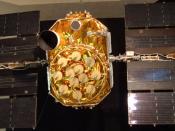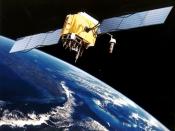The Global Positioning System involves the use of transmission of at least 4 radio wave signals from a "constellation" of 24 earth-orbiting satellites at one time.
A Global Positioning System (GPS) unit consists of a space segment, a control segment, and a user segment. The space segment is a constellation of two-dozen satellites orbiting the earth twice every 24 hours, at approximately 10,900 nautical miles above the earth's surface. The control segment is a series of monitoring stations located at different sites on earth. These stations update and correct errors in the navigational message of the satellites. The user segment is a receiver that receives radio waves from the satellites in orbit, which keeps track of how far away each satellite is.
In general there are normally 8 or so satellites "visible" to a GPS hand-held receiver at any given moment. Each satellite contains an atomic clock. The satellites send radio wave signals to the GPS receivers so that the receivers can find out how far away each satellite is at a given time.
From this, the receiver is able to work out how far it is from the satellite. Since we know how fast radio signals travel -- they are electromagnetic waves traveling at the speed of light, about 186,000 miles per second in a vacuum - we can figure out how far they have traveled by figuring out how long it took for them to arrive. The use of these waves are very convenient as they travel extremely fast and can travel through space, and are not damaging to human beings.
With this information from four or more satellites, the receiver is able to calculate its position to quite a high accuracy on the Earth. Information from four satellites is used simultaneously to pinpoint the precise position...


